Hello, I’m Dr. Candy Akers, a seasoned veterinarian with years of experience treating our beloved four-legged companions. Over the years, I’ve encountered countless cases of fungal infections in dogs, ranging from mild irritations to more severe conditions. It’s always been my mission to provide pet owners with the knowledge and tools they need to ensure the health and well-being of their furry family members. In this blog, I’ll be delving into the world of antifungal wipes for dogs, a topic I believe every dog owner should be well-informed about.
From understanding the nuances of canine fungal infections to navigating the myriad of over-the-counter options, I’ll guide you through the best medicated solutions, ranked and vetted by professionals like myself. Let’s embark on this informative journey together, ensuring our pets remain happy, healthy, and free from discomfort.
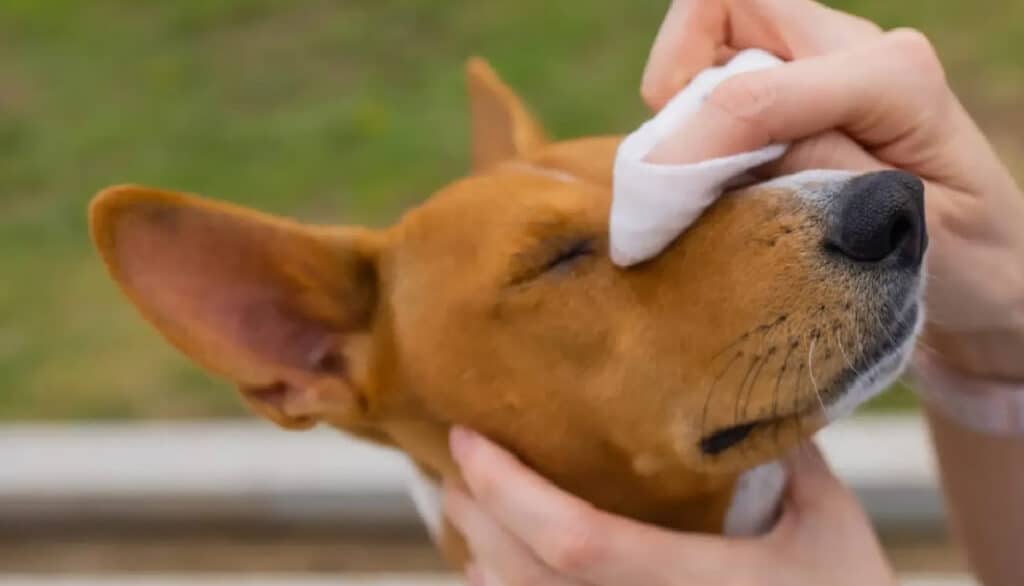
Understanding Canine Fungal Infections
Fungal infections in dogs, while common, are often misunderstood by many pet owners. These infections can manifest in various ways and can affect different parts of a dog’s body. Let’s delve deeper into this topic to equip you with the knowledge you need to identify, treat, and prevent these infections in your furry friend.
1. What are Canine Fungal Infections?
The overgrowth of fungi, which are microorganisms thriving in warm, moist environments, causes fungal infections in dogs. While some fungi are naturally present on a dog’s skin and cause no harm, an imbalance can lead to infections.
2. Common Types of Fungal Infections in Dogs:
- Ringworm (Dermatophytosis): Contrary to its name, ringworm is not a worm but a fungal infection. It’s characterized by circular, red, scaly patches on the skin and can be contagious to other animals and even humans.
- Yeast Infections (Malassezia dermatitis): Often found in a dog’s ears, paws, and skin folds, this infection is caused by an overgrowth of yeast. Symptoms include itching, redness, and a distinct odor.
- Aspergillosis: This is caused by the Aspergillus fungus and primarily affects a dog’s nasal cavity. Symptoms include nasal discharge, bleeding from the nose, and swelling of the nose.
3. Symptoms to Watch Out For:
- Itching or scratching more than usual
- Red, inflamed, or scaly skin
- Hair loss in patches
- Unpleasant odor from the skin or ears
- Discharge from the ears or nose
- Swelling or warmth in affected areas
4. Causes and Risk Factors:
Several factors can predispose a dog to fungal infections, including:
- Humid and warm environments
- Compromised immune system
- Allergies
- Hormonal imbalances
- Prolonged use of antibiotics or steroids
5. The Importance of Early Detection and Treatment:
Early detection of fungal infections is crucial. Left untreated, these infections can spread to other parts of the body or even to other pets and humans in the household. Moreover, chronic infections can lead to more severe health issues and discomfort for your dog.
Understanding canine fungal infections is the first step in ensuring the health and comfort of your pet. By recognizing the signs and knowing the causes, you can take proactive measures to prevent these infections or seek timely treatment if they do occur.
Why Use Antifungal Wipes for Dogs?
As a veterinarian, I often get asked about the most effective and convenient methods to treat and prevent fungal infections in dogs. One solution that has gained popularity and proven efficacy over the years is the use of antifungal wipes. Let’s explore the reasons behind their rising prominence in canine care.
- Convenience and Ease of Use: Antifungal wipes are incredibly user-friendly. They come pre-moistened, eliminating the need for mixing solutions or messy applications. For busy pet owners, these wipes offer a quick and hassle-free way to address fungal concerns, especially when on the go or during travels.
- Targeted Treatment: Unlike broad-spectrum treatments like shampoos or sprays, antifungal wipes allow for precise application. This means you can focus on specific areas of concern, such as paws, skin folds, or ears, ensuring that the medication reaches the exact spot where it’s needed most.
- Prevention of Fungal Spread: Regular use of antifungal wipes can help prevent the spread of fungal infections. By routinely cleaning areas prone to fungal growth, you can keep the microbial balance in check and reduce the risk of infections taking hold.
- Less Stress for Your Dog: Many dogs are not fans of baths or sprays. Antifungal wipes offer a less intrusive alternative. Their gentle application causes minimal discomfort, making the treatment process less stressful for both you and your pet.
- Complementary to Other Treatments: Antifungal wipes can be used alongside other treatments. For instance, if your dog is on oral antifungal medications, using wipes can offer an added layer of protection and speed up the healing process.
Antifungal wipes for dogs offer a blend of convenience, efficacy, and safety. They serve as a valuable tool in the arsenal of any pet owner looking to safeguard their canine companion from the discomfort and risks associated with fungal infections.

Top Medicated OTC Antifungal Wipes Ranked By A Vet – Dr. Candy’s Recmmendations
Navigating the vast array of over-the-counter antifungal products can be overwhelming for any pet owner. With so many brands and formulations available, how do you determine which one is the best fit for your furry friend? As a veterinarian with years of experience in canine care, I’ve taken the time to evaluate and rank the top medicated OTC antifungal wipes available in the market. In this section, I’ll share my expert insights, breaking down the features, pros, and cons of each product, so you can make an informed decision tailored to your dog’s specific needs. Let’s dive in and uncover the best solutions for keeping fungal infections at bay.
Vetnique Labs Dermabliss Dog – Chlorhexidine Ketoconazole Pet Wipes, 50ct Skin Wipes
Pros:
- Veterinary Strength Formula: The wipes contain 2% Chlorhexidine, a disinfectant that helps decrease bacteria on the skin, and 1% Ketoconazole, an antifungal ingredient. This combination makes the wipes effective in treating skin infections like ringworm and seborrhea.
- Easy and Convenient: The small wipes are designed for on-the-go use, making them convenient for both in-home and outdoor situations. They are specifically formulated for pets, allowing for quick and easy cleaning.
- Soothing Relief with Aloe: The wipes contain Aloe Vera Leaf Juice, which provides soothing relief for itching and irritated skin. This can be especially beneficial for pets with allergies or skin sensitivities.
Cons:
- Some customers reported that the product leaves a residue after application, which may be unpleasant for some pet owners and their animals.
Great For: Irritated skin, mild infections
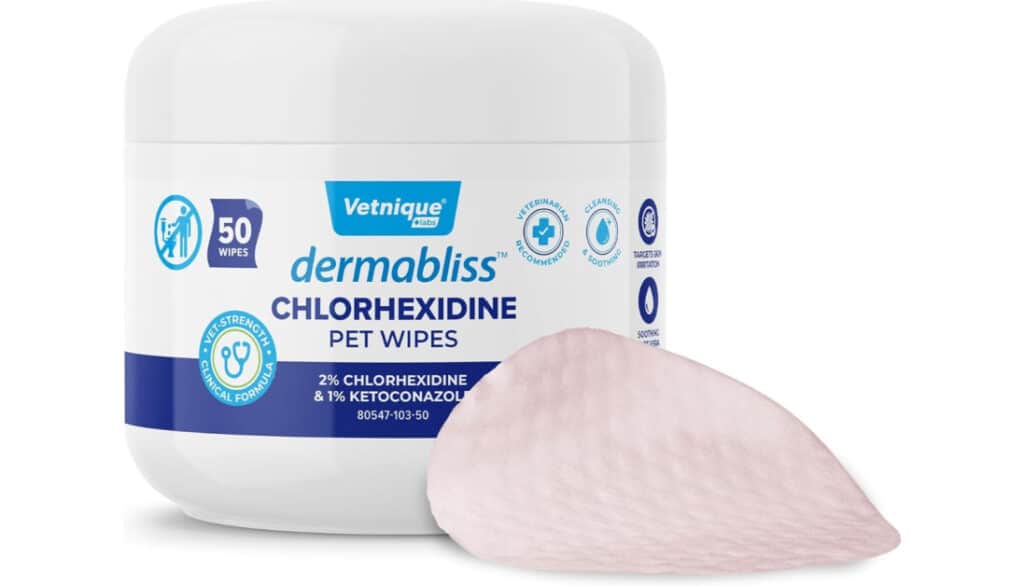
Smiling Paws Pets – Antibacterial & Antifungal Wipes for Dogs & Cats (with Chlorhexidine & Ketoconazole)
PROs:
- Effective Treatment: The Smiling Paws Pets Medicated Antibacterial & Antifungal Wipes are formulated with active ingredients, such as Ketoconazole and Chlorhexidine, that help treat and eliminate various skin infections in dogs and cats, including yeast infections, fungus, bacteria, mange, ringworm, hotspots, and pyoderma.
- Perfect Size: These wipes are designed to be wet, small (2.5″x2.5″), and thin enough to fit into every crevice, such as paws, without causing discomfort to your pet. They are ideal for hot spot treatment for dogs’ paws and for treating bacterial, fungal, and yeast infections.
- Soothing and Satisfying: In addition to their effective active ingredients, these wipes also contain soothing Aloe and Essential Fatty Acids, which help soothe infected areas and provide relief to your pet. They are great for hot spot treatment, mange treatment, pyoderma, ringworm, and other skin infections.
CONs:
- Small Quantity: The package contains a limited number of wipes, which may not be enough for long-term or repeated use, especially if you have multiple pets or if your pet requires ongoing treatment.
- Scent: Some customers have reported that the scent of these wipes is not very pleasant, which may be a drawback for those who are sensitive to strong odors or who prefer scent-free products.
Great For: Hot Spots, Superficial Infections, crusty hairloss along edge of ear
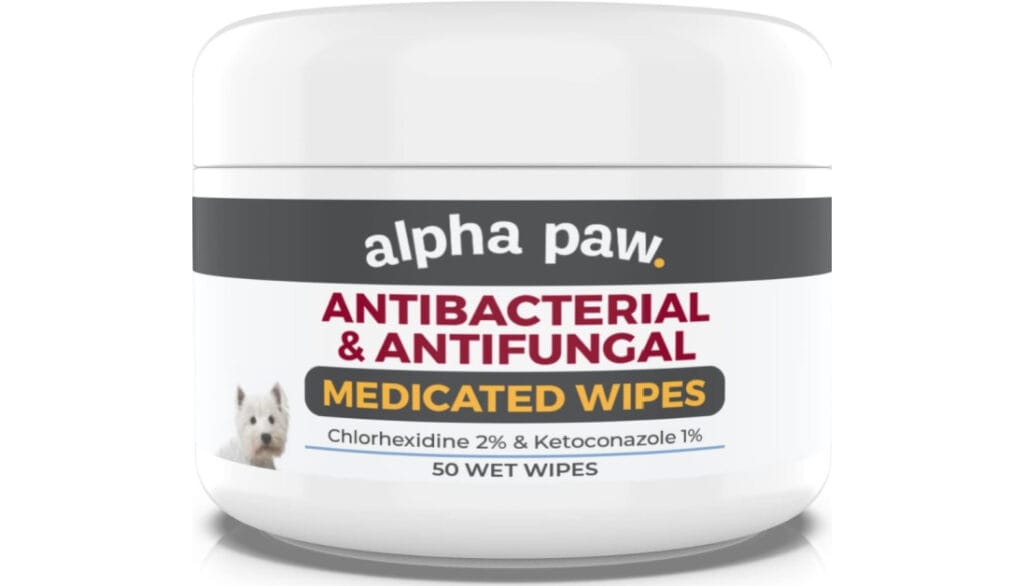
Dechra MiconaHex + Triz Wipes For Dogs, Cats & Horses (50ct)
Pros:
- The Dechra MiconaHex + Triz Wipes are versatile and suitable for dogs, cats and horses, making it a convenient option for households with multiple pets.
- According to customer reviews, the product is effective in treating skin issues like yeast and other infections, reducing pet’s discomfort and symptoms like itching and redness.
- The wipes are reportedly easy to use, offering a convenient and less messy alternative to shampoos and sprays.
Cons:
- Some customers have mentioned that the wipes are relatively small, which may make them less effective for larger pets or wiping down larger affected areas.
- The product is considered expensive, with only 50 wipes included per pack, making it a potentially costly solution for ongoing skin issues.
Great For: Small spots or areas with crusty hairloss
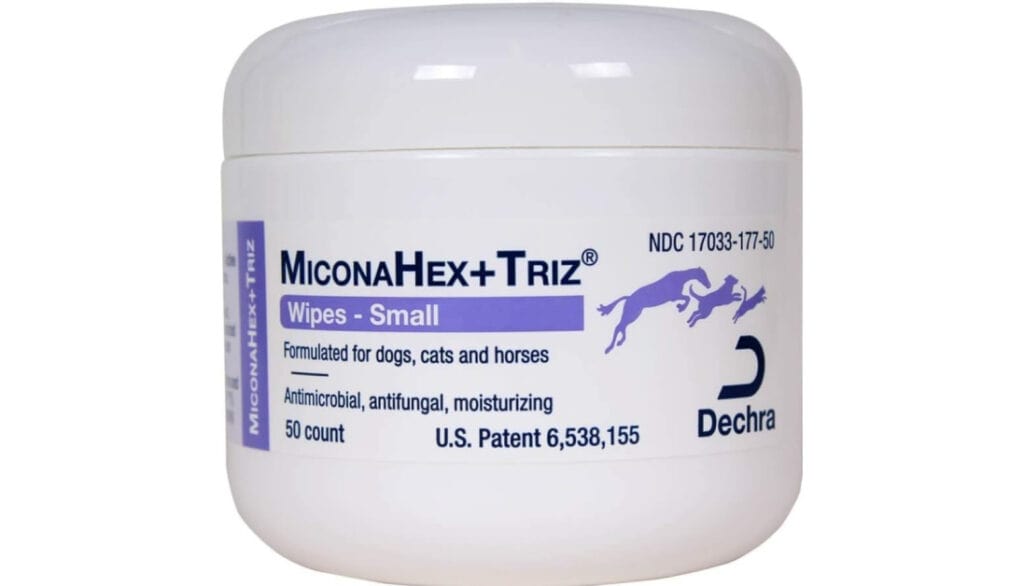
Nootie Medicated Dog Wipes, 2% Chlorhexidine and 2% Miconazole Formulated Pet Wipes
PROs:
- The Nootie Medicated Dog Wipes are formulated with 2% Chlorhexidine and 2% Miconazole, which are effective in treating symptoms of ringworm, hotspots, allergy dermatitis, and ear and skin infections.
- These wipes are 2″ in size, ideal for use on hard-to-reach areas. They also come in a pack of 70, providing a good quantity of wipes.
- Easy to use and efficient. They have successfully helped in treating skin irritations and itchiness of pets, demonstrating efficacy.
CONs:
- Some users believe the smell of the wipes is quite strong. While not necessarily unpleasant, it smells as if there is an added fragrance which some people might find unnecessary or even bothersome.
- They can also leave a sticky residue on hands after use.
Great For: Stubborn fungal infections, ringworm

Curaseb Cat & Dog Ear Infection Treatment Wipes
PROs:
- Powerful and Effective: The Curaseb Cat & Dog Ear Infection Treatment Wipes are formulated to soothe itchy and inflamed ears, and cleanse away wax, dirt, and discharge, providing relief from irritation.
- Quality and Safety: Curaseb prioritizes quality and safety, making all their pet health products in the USA using high-quality ingredients.
- Easy to Use, Refreshing Scent: The wipes are user-friendly, making the cleaning process quick and efficient. They also have a pleasant cucumber melon scent that leaves your pet’s ears smelling fresh.
CONs:
- Limited Quantity: While the package contains a decent number of wipes (100 count), for pets with chronic ear infections requiring daily cleaning, these may run out quickly, necessitating frequent repurchases.
- May Not Work For All Breeds: It might take a few days to show noticeable effects on certain pets. No one product works exactly the same for every pet; some might require a longer duration of use or might not respond to the product as effectively.
Great For: Puppies and breeds with shorter hair
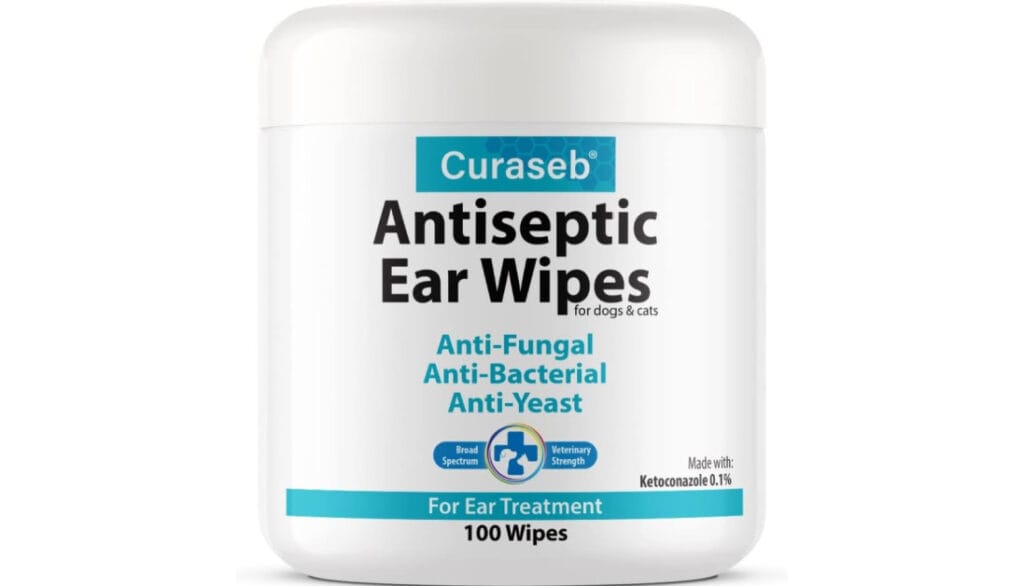
Ingredients to Look for in Antifungal Wipes
When selecting antifungal wipes for your canine companion, it’s essential to understand the active ingredients and their benefits. The right ingredients can make a significant difference in the effectiveness of the wipe, ensuring rapid relief and prevention of future infections. Here’s a breakdown of the key ingredients to look for and why they matter:
1. Ketoconazole:
- What it is: An antifungal medication commonly used to treat fungal infections.
- Benefits: Ketoconazole disrupts the fungal cell membrane, leading to the death of the fungus. It’s effective against a wide range of fungi, making it a top choice for many antifungal products.
2. Chlorhexidine:
- What it is: An antiseptic and disinfectant often found in veterinary products.
- Benefits: Chlorhexidine has both antifungal and antibacterial properties. It helps in reducing the number of yeast and bacteria on the skin, preventing infections and promoting a healthy skin environment.
3. Aloe Vera:
- What it is: A natural plant extract known for its soothing properties.
- Benefits: While not antifungal in itself, aloe vera provides relief from itching and inflammation associated with fungal infections. It also promotes skin healing and hydration.
4. Witch Hazel:
- What it is: A natural astringent derived from the witch hazel shrub.
- Benefits: Witch hazel helps reduce skin inflammation and soothe irritated skin. It can also aid in drying out weepy skin conditions, making it harder for fungi to thrive.
5. Boric Acid:
- What it is: A compound with antiseptic properties.
- Benefits: Boric acid can inhibit the growth of fungi and bacteria. It’s particularly effective against yeast infections and can help restore the skin’s natural pH balance.
6. Salicylic Acid:
- What it is: A beta hydroxy acid often used in skincare products.
- Benefits: Salicylic acid aids in exfoliating dead skin cells, preventing the buildup that can create a breeding ground for fungi. It also helps in reducing inflammation and redness.
When choosing antifungal wipes for your dog, it’s crucial to read the ingredient list and understand their functions. Opt for products that combine antifungal agents with soothing ingredients to ensure effective treatment and relief for your pet. Always consult with your veterinarian if you’re unsure about the best product for your dog’s specific needs.
Safety Precautions When Using Medicated Wipes
Using medicated wipes can be a game-changer in managing and preventing fungal infections in dogs. However, as with any medication or treatment, it’s essential to use them responsibly and safely. Here are some crucial safety precautions to keep in mind when using antifungal medicated wipes for your canine companion:
1. Read and Follow Label Instructions:
- Always read the product label carefully before use. Different wipes may have varying instructions regarding frequency of use, application method, and storage.
2. Avoid Eye and Mouth Areas:
- While most wipes are formulated for safe use on skin, they can be irritating if they come into contact with your dog’s eyes or mouth. Always avoid these sensitive areas when applying.
3. Monitor for Allergic Reactions:
- Just like humans, dogs can have allergic reactions to certain ingredients. After using a wipe for the first time, monitor your dog for any signs of irritation, redness, or unusual behavior. If you notice any adverse reactions, discontinue use and consult your vet.
4. Store Out of Reach:
- Ensure that the wipes are stored in a place inaccessible to your dog (and other pets). Some dogs might be tempted to chew on the packaging, which can lead to ingestion of harmful substances.
5. Wash Hands After Use:
- Even though many medicated wipes are safe for pets, it’s a good practice to wash your hands after application to avoid any potential transfer of medication to your eyes, mouth, or other sensitive areas.
While medicated antifungal wipes are a valuable tool in canine care, it’s essential to use them with caution and awareness. By following these safety precautions, you can ensure the well-being of your furry friend while effectively addressing fungal concerns.
Vet’s Tips for Effective Use of Antifungal Wipes
Utilizing antifungal wipes can be a straightforward and effective method to combat fungal infections in dogs. However, to maximize their benefits and ensure the safety of your pet, it’s essential to use them correctly. As a veterinarian, I’ve compiled a list of tips to guide you in the optimal use of these wipes:
1. Clean the Area First:
- Before applying the antifungal wipe, gently clean the affected area with a damp cloth to remove any dirt or debris. This ensures that the medicated solution penetrates the skin effectively.
2. Apply with Gentle Pressure:
- Use a gentle, circular motion when applying the wipe to ensure the medication is adequately distributed. Avoid rubbing too hard, as this can cause irritation.
3. Allow the Area to Air Dry:
- After using the wipe, let the treated area air dry. This allows the medicated solution to be absorbed fully and prevents your dog from immediately licking it off.
4. Distract Your Dog Post-Application:
- Some dogs might be tempted to lick the treated area. Distract them with a toy or treat for a few minutes after application to ensure the medication has time to work.
6. Rotate Wipes Regularly:
- If you’re using a container of pre-moistened wipes, rotate the stack occasionally to ensure the top wipes remain moist and effective.
7. Check for Sensitivities:
- Before using the wipe on larger areas, test it on a small patch of your dog’s skin. This helps identify any sensitivities or allergic reactions early on.
8. Regular Vet Check-ups:
- Even if you’re treating a fungal infection at home, regular check-ups with your vet are crucial. They can monitor the progress, advise on the treatment’s duration, and make any necessary adjustments.
While antifungal wipes are a convenient tool in managing fungal infections, their effectiveness largely depends on how they’re used.

Conclusion
Fungal infections in dogs, though common, can be a source of significant discomfort for our furry companions. As responsible pet owners, understanding the nuances of these infections and the available treatments is paramount. Antifungal wipes have emerged as a convenient, effective, and safe solution in this regard. From understanding their key ingredients to ensuring their optimal use, we’ve delved deep into the world of canine fungal care in this blog. Remember, while these wipes are a valuable tool, always consult with a veterinarian for severe or persistent cases. Your dog’s health and comfort are paramount, and with the right knowledge and tools at your disposal, you can ensure they remain happy, healthy, and free from the distress of fungal infections. Here’s to many more itch-free days with your beloved pet!
Frequently Asked Questions
The frequency of use largely depends on the severity of the infection and the specific product’s recommendations. For mild cases, daily application might suffice, while more severe infections might require multiple applications daily. Always follow the product label’s instructions and consult with your vet for personalized advice.
It’s essential to use products specifically formulated for dogs. Human antifungal wipes might contain ingredients that are too strong or potentially harmful for canine skin. Always opt for dog-specific products to ensure safety and effectiveness.
Most antifungal wipes for dogs are formulated to be safe even if ingested in small amounts. However, it’s best to distract your dog and allow the treated area to dry after application to ensure maximum effectiveness. If your dog shows any signs of distress after licking the area, consult your vet immediately.
The duration for visible improvements can vary based on the infection’s severity and the product used. Generally, with consistent use, you might notice improvements within a week. However, it’s crucial to continue the treatment as recommended to prevent recurrence.
Most dogs tolerate antifungal wipes well. However, some might experience mild skin irritation or allergic reactions to certain ingredients. Always monitor your dog after the first few applications and consult your vet if you notice redness, swelling, or any other adverse reactions.
